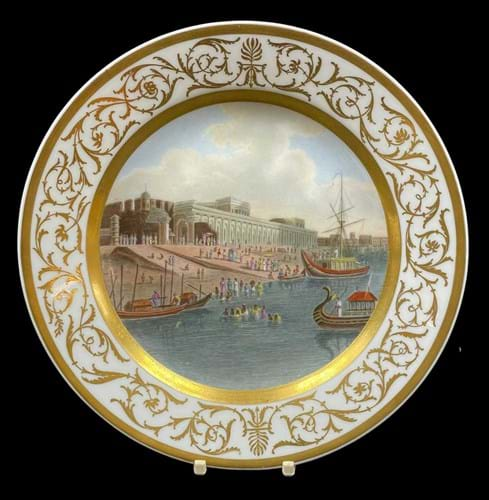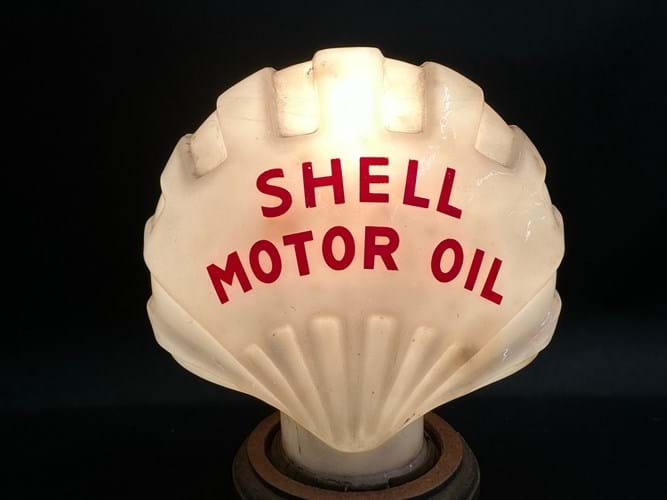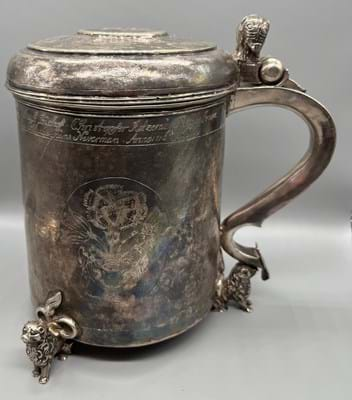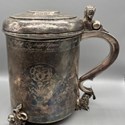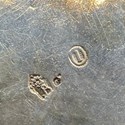1. Swansea porcelain plate – £5000
The Welsh Sale held by Rogers Jones in Cardiff on April 1 included this exceptional Swansea porcelain dessert plate. The decoration, taken from Thomas Daniell's famous Views of Calcutta published in 1788, is painted by Thomas Baxter (1782-1821), the celebrated ‘Worcester’ porcelain painter who worked for Swansea from 1816-19.
The scene shows the ghat (steps) descending from the old Fort William to the River Hooghly.
The inscription to the base references the tragedy of the Black Hole of Calcutta that had cost the lives of so many captured British troops half a century earlier. It reads: ‘Within the walls of this fort is the black hole, whose name is eternized by the sufferings of Mr [John Zephaniah] Holwell and his ill-fated companions in 1756’.
This plate is well known, having been pictured in the book Thomas Baxter, The Swansea Years 1816-1819 by John Wilstead and Bernard Morris (1997).
It came for sale as part a consignment from the family of preeminent Welsh porcelain collector Sir Leslie Joseph. Much of his superb collection was sold by Sotheby’s in 1992 but some fine pieces, each bearing his collecting label, had remained in the family.
Prices for these pieces have come down a lot in recent years as the buying pool becomes smaller but this prize (in fine condition) did sell at the top end of a £4000-5000 estimate.
2. Lucie Rie plaster mould – £4200
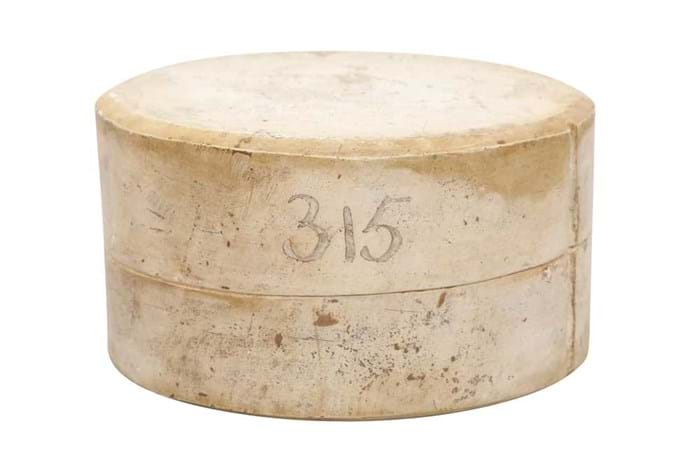
A plaster mould for making buttons, given by Lucie Rie to her cleaning lady, £4200 at Chiswick Auctions.
Two moulds for making buttons, given by studio potter Lucie Rie (1902-95) to her cleaning lady were sold by Chiswick Auctions on March 29. The vendor’s mother had worked for many years at Rie’s home and studio at 18 Albion Mews, Paddington.
Lucie Rie is best remembered for her bowl and bottle forms. However, during and after the war, to make ends meet, she made glass and ceramic buttons and jewellery for couture fashion outlets.
She was employed by her countryman Fritz Lampl (1892-1955), the founder of the Bimini Glass company in Vienna who, after fleeing Nazi Austria, relaunched his glass blowing venture in Soho under the name Orplid in 1938. Its most popular line was a series of hand-made glass buttons, some fashioned using plaster casts of Roman coins supplied by the British Museum.
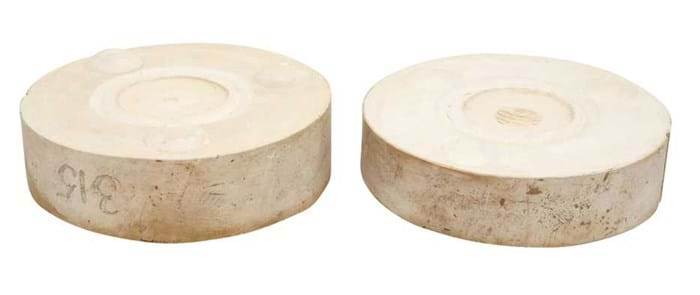
A plaster mould for making buttons, given by Lucie Rie to her cleaning lady, £4200 at Chiswick Auctions.
The two-piece plaster moulds, one with the number 315 and the other with Baltasar, both carried a carved 'Bimini' mark.
Chiswick’s design specialist Maxine Winning dated them to the 1940s or 50s. “These are emotive objects that take us back to Lucie Rie’s first days in London as an emigrée. Fritz Lampl was an important figure in her life. Not only did he give her work in wartime London, but he encouraged her to experiment with making buttons in ceramics.”
The buttons themselves are keenly collected and bring substantial prices when they come to auction. The moulds, offered as two lots, took £4200 and £4000. Both sold to a buyer in Geneva.
3. Shell glass pump globe – £14,000
The sale of automobilia at Richard Edmunds Auctions in Chippenham on March 25 included a total of 16 different glass pump globes advertising Shell products. All were different in some small way – either by shape, by colour, by logo, by maker or by product.
In additional to globes for Shell Economy (£900), Shell Diesoline (£340), Super Shell (£1200) and Sealed Shell (£550) were two rare smaller globes for Shell Motor Oil. Both were offered in excellent original ‘barn find’ condition (they had languished in the bottom of a cabinet for several decades) with guides of £3000-5000 each.
One made £12,000, the next £14,000, selling to different buyers.
These globes for motor oil dispensers were roughly half the size or petrol pump globes. They were made in smaller quantities and survive in only small numbers. This type is well known from modern reproductions, but originals are very hard to find. The auctioneers had only sold one before that took £5800 five years ago.
4. Norwegian silver peg tankard – £11,200
The name 'peg tankard' is derived from the vertical row of pegs inside that can be used to measure the amount of alcohol drunk as the tankard was passed around the table. The form, made in wood and in silver, was particularly prevalent in Scandinavia.
This 8in (21cm) Norwegian example with three standing lion feet and a cast elephant thumbpiece provided the top lot at the sale at Bowler and Binnie (20% buyer’s premium) in Dunfermline on March 31. Estimated at £2000-3000, it took £11,200 following a battle between dealers and collectors.
The form and decoration is typical of many vessels the final third of the 17th century and it has marks for Bergen. However, it has some uncommon features such as the elephant thumbpiece and the engraved decoration of tulips and other blooms against a tooled ground. The band of text is a presentation inscription dated July 16, 1716 and to the lid the words bagerlaugs kande – bakers guild jug.
5. David Roberts watercolour – £20,000

A watercolour of Jaffa dated March 26, 1839 from The Holy Land series by David Roberts, £20,000 at Sworders.
From the Grand tour onwards, the watercolour, by dint of its portability, became the medium of choice for the topographical artist.
One of the pioneers of the Orientalist movement in the 19th century was David Roberts RA (1796-1864). It was his famous journey to Egypt and The Holy Land of 1838-39, the first unaided journey to the region made by a Western artist, that inspired future generations.
This watercolour of Jaffa, offered at Sworders’ sale of Old Masters, British and European Art on April 4, is dated March 26, 1839, and was probably painted on the spot. Depicting the ancient city port of Judea where Noah is said to have built the Ark it features the colourful costumes, the exotic animals and the impressive architecture and ancient monuments that made the region so appealing to Western eyes.
Roberts made several views of the Jaffa, two of which were converted into lithographs for his monumental three-volume publishing project The Holy Land. This particular scene, blending masterful depiction of architectural detail with sweeping, less resolved areas of landscape, is taken from near the same viewpoint as the lithograph Jaffa Looking South.
Part of a London private collection that included several very fine watercolours, it was guided at £20,000-30,000 but – in a difficult market for this most traditional of British collecting genres – only got away at the low estimate.


